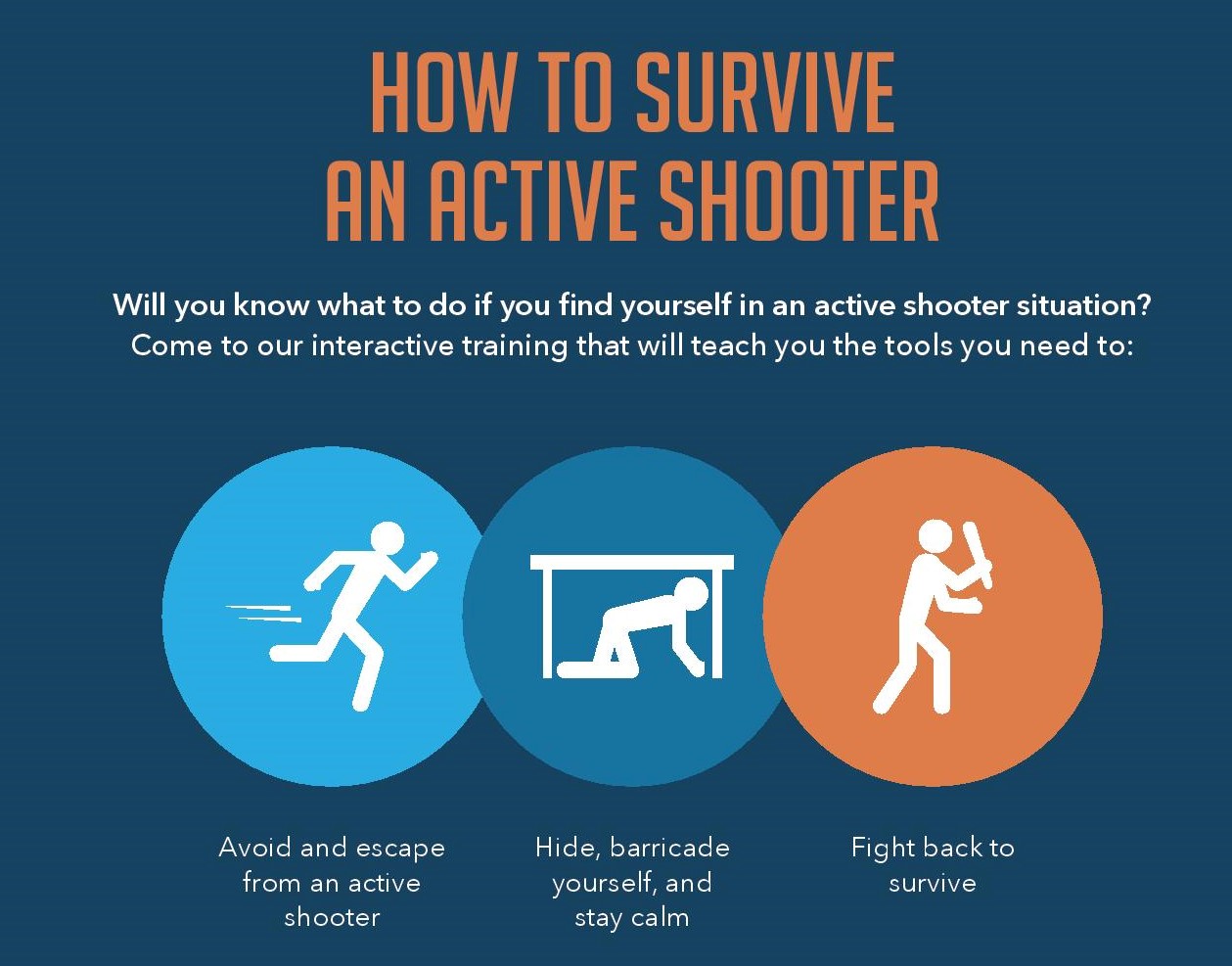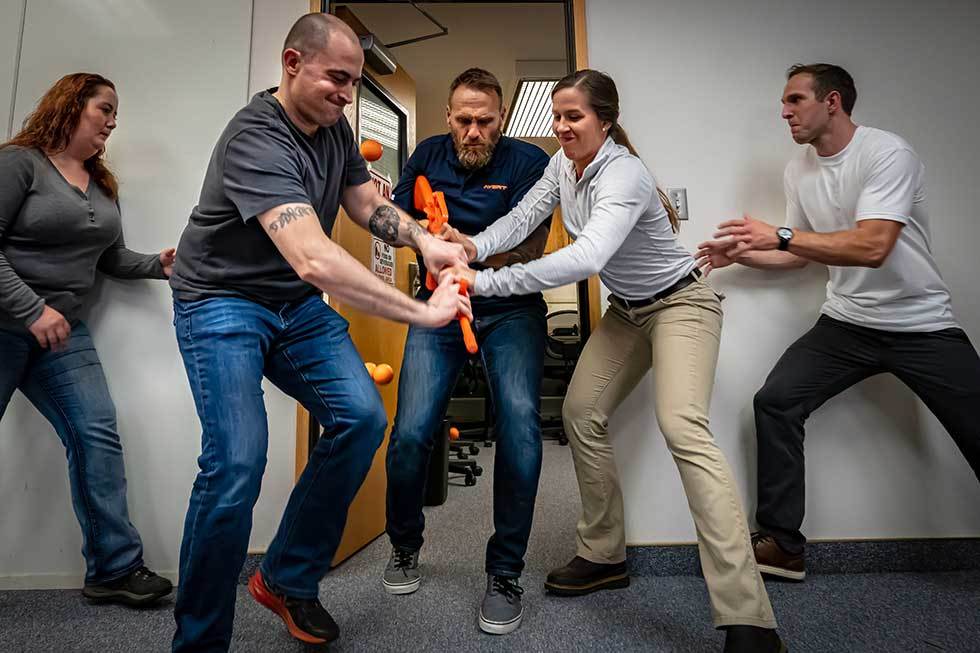How Active Shooter Training Can Conserve Lives in Crisis Situations
How Active Shooter Training Can Conserve Lives in Crisis Situations
Blog Article
Implementing Active Shooter Training: Ideal Practices for Creating a Safe and Prepared Community Setting
As neighborhoods face the distressing fact of energetic shooter incidents, the implementation of extensive training programs comes to be imperative. A successful technique depends upon not only the advancement of customized educational programs that address neighborhood dangers yet additionally the participation of diverse stakeholders. By employing a range of training techniques, areas can guarantee that all participants are geared up with vital abilities. The difficulty lies in keeping an adaptive structure that evolves with arising threats. What are the critical aspects that can transform a common training program into a robust model for community strength?

Understanding the Requirement for Educating
In an era marked by boosting events of violence in public spaces, understanding the need for energetic shooter training has never ever been much more essential. The frequency of mass shootings across numerous environmentsâEUR" such as institutions, offices, and shopping centersâEUR" highlights the necessity for people and organizations to be planned for such emergencies. Active shooter situations can unfold swiftly, leaving little time for people to react efficiently. Thorough training initiatives can equip participants with the knowledge and abilities to respond emphatically.
Training fosters a sense of empowerment and preparedness, allowing people to feel even more protected in their surroundings. The benefits of active shooter training prolong beyond instant action; they include improving communication procedures and improving general safety and security procedures within organizations.
Trick Parts of Effective Programs
Effective active shooter training programs include a number of vital components that improve preparedness and reaction abilities. First, detailed curriculum development is crucial, making sure that training material matters, evidence-based, and tailored to the particular requirements of the organization or community. This consists of recognizing the characteristics of active shooter events and the mental influence on people involved.
2nd, reasonable training circumstances must be utilized to simulate prospective circumstances, allowing individuals to exercise decision-making and response strategies in a regulated environment. These drills promote muscle mass memory and develop confidence amongst individuals.
Third, a concentrate on interaction protocols is crucial. Establishing clear lines of interaction amongst police, emergency situation responders, and individuals makes sure collaborated reactions during an occurrence. Normal updates and refresher training courses aid keep communication pathways clear and effective.
4th, recurring analysis and responses devices need to be integrated into the training program - active shooter training. Analyzing the effectiveness of training via individual responses and performance metrics permits continuous enhancement
Finally, promoting a culture of security and preparedness within the community urges caution and aggressive procedures, making certain that individuals are not only experienced but likewise engaged in maintaining a safe setting.
Engaging Neighborhood Stakeholders

To efficiently involve these stakeholders, it is necessary to interact the purposes and advantages of the training. Organizing informational sessions can help clarify the training's function, address issues, and outline the roles each stakeholder may play. Creating a stakeholder advisory committee Source can help with recurring dialogue, enabling for varied point of views and understandings to be incorporated into the training program.
Building connections with community leaders and organizations is also important. Their assistance can improve outreach efforts, rise engagement, and guarantee that training is tailored to the unique demands of the community. In addition, stakeholders can assist in disseminating details and sources, strengthening the message of safety and security and readiness.
Ultimately, engaging area stakeholders not only reinforces the training effort but also grows a feeling of ownership among homeowners, causing an extra resilient and enlightened community with the ability of reacting successfully to potential hazards.
Training Distribution Methods
Using a selection of training shipment techniques is important to suit the diverse discovering styles and demands of participants in active shooter training programs (active shooter training). Reliable training can take several kinds, consisting of lectures, hands-on simulations, online components, and interactive workshops. Each technique serves a special objective and can enhance the overall discovering experience

On-line components use adaptability and accessibility, making it possible for individuals to learn at their own pace. These can consist of videos, quizzes, and discussions to gauge understanding. Interactive workshops encourage group conversations and analytical, promoting team effort and communication skills.
Incorporating a mixed strategy that integrates these methods not only enhances the training experience however likewise makes sure that participants are much better prepared to react efficiently in the event of an energetic shooter situation (active shooter training). By attending to numerous discovering choices, companies can develop a more enlightened and responsive community
Constant Evaluation and Enhancement
Routine analysis and improvement of energetic shooter training programs are crucial to maintaining their importance and efficiency. As hazards evolve, so should the approaches and techniques employed in training. Continuous examination ensures that training content reflects the most up to date intelligence on active shooter incidents, integrating lessons picked up from recent occasions and adjusting for arising trends.
To discover this info here facilitate this process, organizations must establish comments systems that include participant evaluations, specialist testimonials, and case debriefs. Collecting data on participant efficiency during drills and recommended you read exercises is important, as it highlights locations requiring renovation and educates future training sessions. Additionally, involving with legislation enforcement and emergency situation responders can provide useful insights right into the usefulness and applicability of training methods.
Regularly set up evaluations of training products and techniques should be mandated, cultivating an environment of development and versatility. Organizations must additionally urge a society of recurring understanding, where employee really feel equipped to suggest modifications based on their experiences. By dedicating to continual analysis and improvement, companies not just improve the effectiveness of their active shooter training programs however additionally strengthen their general commitment to security and readiness within the area.
Conclusion
In conclusion, efficient execution of energetic shooter training demands an extensive method that prioritizes area interaction and sensible simulations. Ultimately, a dedication to ongoing training and enhancement cultivates a society of vigilance and readiness, ensuring a much safer setting for all neighborhood members.
Report this page